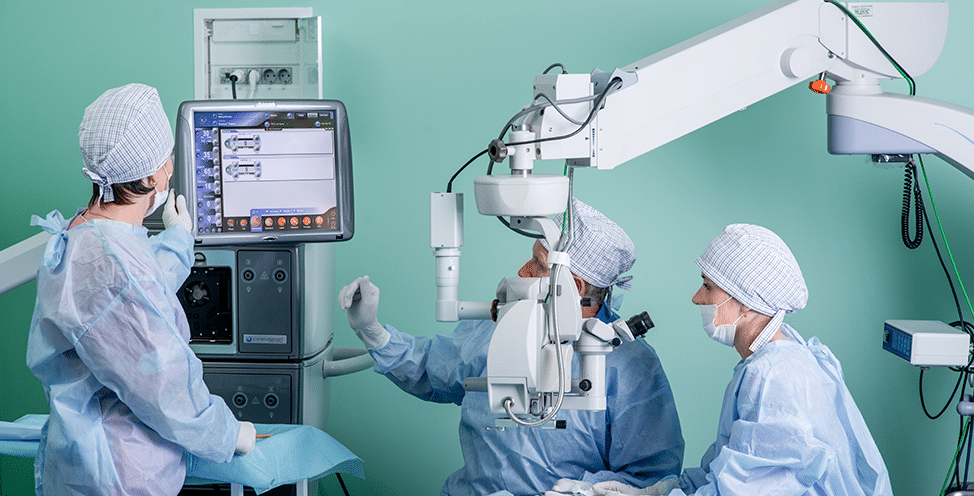
Important information for patients getting ready for surgery is provided at the bottom of the page under Articles link.
At Oculus Medical Center we utilize the following two techniques of cataract surgery:
1.1 Phacoemulsification
It is the perfect technique of cataract surgery. This procedure utilizes a tunnel-shaped 2.0 to 2.5 mm wide incision of the cornea. This incision does not require sutures, the technique thereby being sutureless. A phaco-tip is introduced into the eye via the tunnel incision. Then the cataract is destroyed using ultrasound energy (turned into emulsion) and removed. Instead, a flexible lens is implanted through the tunnel to serve as the eye lens. This artificial lens is folded and implanted into the eye, where it unfolds and is attached in the most perfect physiological location – in the capsule of the natural lens.
The surgery results in fast restoration of vision.
At our medical center we perform phacoemulsification of cataract regardless of its maturity degree. The surgery is performed on Laureate or Constellation machinery manufactured by Alcon. We utilized high quality disposables and flexible IOL’s from the world’s best manufacturers, chosen by our patients in accordance with their wishes and resources. This ensures high visual acuity and rapid recovery unless comorbidities are present.
If cataract is accompanied by myopia or hypermetropia, these are corrected by proper selection of power of the artificial lens. We also implant toric lenses to correct for astigmatism, thus eliminating the need to wear cylindrical spectacles.
Multifocal or pseudo-accomodating lenses can be implanted to eliminate presbyopia. This type of IOL improves visual acuity without the use of spectacles at different focal distances, including close, large distance, and at computer.
State of the art equipment and techniques enable us to perform phacoemulsification:
Relative contraindications to phacoemulsification:
1.2. Extracapsular cataract extraction
In some cases, when phacoemulsification is not an option because of the contraindications, extracapsular cataract extraction is performed.
The surgeon removes the nucleus of the lens as a whole, without destroying it with ultrasound. Therefore this procedure requires a longer incision, than phacoemulsification. After implantation of the artificial lens the incision is sealed with sutures.
Extracapsular cataract extraction is reserved for complicated cases only and requires high surgical qualification. This is not a procedure to be performed at every clinic!
Owing to the high expertise of our surgeons and the cutting edge equipment, we are able to perform subluxated or luxated lens removal combined with vitrectomy, IOL suturing to the sclera, as well as anti-glaucoma surgery.
Deep non-penetrating sclerectomy
It is an advanced and safe technique of glaucoma treatment. It consists in creation of additional drainage by removing the external wall of the Schlemm’s canal and the juxtacanalicular part of the trabecule without penetrating the anterior chamber.
Limited endotrabeculectomy
The least traumatic glaucoma treatment technique. This method was developed by professor I.Ya.Novytsky, our clinic’s leading expert. Here the additional drainage is created by removing the external juxtacanalicuar part of trabecule, but from the angle of anterior chamber. The procedure is performed via 1.2 mm incision (like the one used for phacoemulcification), which does not require sutures. This is another example of sutureless surgery.
These procedures alleviate the sharp changes of intraocular pressure (the key factor in complications associated with other glaucoma treatment techniques). Combined cataract-glaucoma surgery may be indicated as well.
What should you know if diagnosed with glaucoma?
Anti-glaucoma surgery technique developed by our clinic’s leading expert professor I.Ya.Novytskiy is remarkable in that it may be combined with the modern technique of cataract surgery. The procedure is performed via a 1.2 mm incision, like the one used for cataract phacoemulcification.
This state of the art approach has a number of advantages:
Vitreo-retinal surgery comprises an intensely developing branch of ophthalmic surgery. This microscopic technique is similar to endoscopic general surgery. Needle-sized microscopic ports are inserted into the eye, serving to maintain the intraocular pressure and to introduce the working instruments (lighting, cutter, tweezers, scissors, laser coagulator, etc.).
Complex approach, and the importance and delicate anatomy of the posterior eyeball are factors requiring extreme precision and concentration during these types of surgery. This is the cutting edge technique in micro-surgery.
Leading experts of our clinic (ophthalmology professor I.Ya.Novytskiy, higher category ophthalmologist T.M.Smal) are the founders of vitreo-retinal surgery in Western Ukraine. Their experience and high expertise are sufficient for the most complex types of surgery.
This gives us the ability to help patients with the following grave conditions:
In our clinic we perform these surgical procedures under the state of the art operating microscope OMS-800 from Topcon (Japan), and the Alcon Constellation vision system (USA). A wide choice of the world’s best disposable is offered to our patient. 25 Gauge technique enables us to perform sutureless surgery with minimal eye trauma.
Thus, Oculus Medical Center is one of the few well-equipped and staffed vitreoretinal surgery centers of the Western Ukraine.
Thereby our patients obtain proper medical care without having to travel to distant medical centers.
We constantly follow the latest advances in ophthalmology in Europe and worldwide. One of such new approaches is pharmacosurgery. This technique implies administration of medications into the eye. The procedure last just a couple of seconds, no longer than a typical injection. However, the injection into the eyeball requires aseptic technique and is therefore performed in the operating room after appropriate preparation.
The most common indications are:
Medications for intraocular administration may include endothelial growth factor inhibitors, long-acting corticosteroids, antithrombotic and fibrinolytic medications.
7. Other


